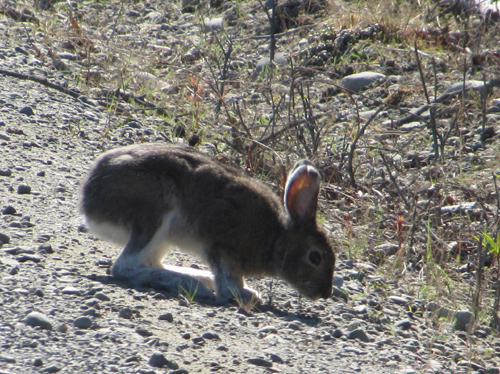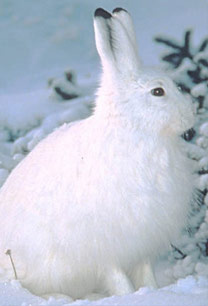Snowshoe Hares live in Connecticut. They have brown fur on top with white underbellies in the summer. They molt to a coat of white fur in the winter. This gives them one of their common names, the Varying Hare. Their hind feet are very large, much larger than those of cottontail rabbits, and have furry soles. They have small tails. Their ears have black tips, even in winter. They weigh 2 to 3 lbs.
Snowshoe Hares range through the very northernmost regions of the US. They range farther south in the Sierra, Rocky and Appalachian mountains. They range through almost all of Canada and Alaska. In Connecticut they are present in the northern regions of the state. Their habitat is forest. They are active year-round and are usually most active at dawn and dusk.
Typical diet in the wild consists of a variety of herbaceous plants during the warm season. In the winter they eat buds twigs and bark. Hares, like rabbits, eat, then retreat to cover. There they will produce soft green droppings that they eat again in order to extract all the nutrients from the plant matter. Firm, dark brown oval pellets are the final result.
Snowshoe Hares mate from early spring through the warm months and produce 2 or 3 litters a year. Snowshoe Hare babies, unlike those of rabbits are born fully-furred, with open eyes and are able to walk and hop very quickly. Snowshoe hares nest in areas where they have packed down vegetation or grasses. The hare babies hide in separate areas. The family gathers daily when the babies come to the mother to nurse for a few minutes.
Snowshoe Hares are one of the smallest of the hares and are solitary. They create forms of trampled vegetation to rest in, or use natural shelters such as hollow logs. Threatened hares can thump their large hind feet. If frightened Snowshoe Hares may head for underbrush when most other hares would head for open ground for better running. If being chased they often circle their territory using well-known paths. Snowshoe Hares can reach speeds of 30 mph and leap 12 feet.
Snowshoe Hares can swim but tend to avoid water. They take dust baths to rid their fur of pests. The white winter coat of a Snowshoe Hare is white only on the tips of the fur. This winter fur camoflages a hare in the snow and also has more insulating ability. The molt is controlled by the length of the daylight hours and in this region they are usually turning to white during October through December. Unlike populations farther north, Snowshoe Hares in Connecticut do not seem to experience population cycles.
Neat Fact
Rabbit and hare are not two different words for the same thing.
The major difference is that rabbits give birth to naked, blind, helpless babies called kits. It takes some time before they are able to move about and they require a more sheltered natal nest and more initial maternal care. Hares give birth to babies who have fur, can see, and can already move about. The young of hare are called leverets.

